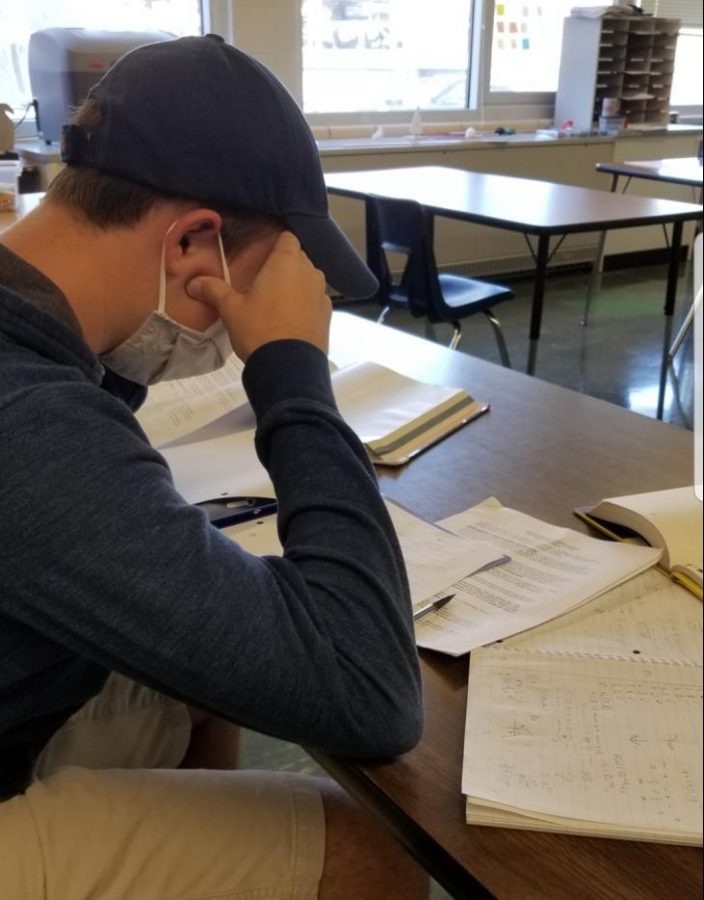Blended learning influences stress levels
Jack Rockwood
Sophomore, David Stuckey working on assignments
October 9, 2020
Blended learning has begun, this means in person attendance, and safety procedures, as well as a blend of confusion, relief, and stress for students and staff.
Sept. 21, blended learning began with Cohort A freshman being allowed into the building Monday and Tuesday, and the rest of Cohort A starting Wednesday. Then the same procedure for Cohort B the week after. Masks are mandatory, classes are socially distanced, and the building is sanitized daily.
Superintendent Dr. John Kellogg said in an article on the district website that, “Phasing in our transition to Blended Learning will give teachers and other staff members time to work with students on important details about their school days and in-person instruction moving forward,”
In blended learning students and staff alike have been feeling stress and uncertainty. Senior Haylee Glover, said, “Yes [it will be more stressful], because it’s new and confusing, it’s going to take a while for teachers and everyone to figure this out.”
Although some students are feeling more stress and wanting to remain in remote learning, others are relieved to be back in a classroom. “The online weeks [in blended learning] are more flexible than when only online. . . and you can talk to your teachers on in-person weeks,” sophomore David Stuckey said.
Another student who is relieved to be in a blended model is senior Chuck Williams. “I think it will be easier, since we will have human connection,” Williams said. “I’m a visual learner; I learn so much better in a classroom.”
According to the Social Science Research Network, 65% of people are visual learners. This should indicate that the majority of students are eager to return to school. However, there is the added factor of confusion from work being online, and on paper, which can lead to stress.
Multiple students have reported an increased workload compared to 4th quarter, even with similar classes. “Yeah, I feel like I’m getting more work than the 4th quarter. I think cause every class is actually giving work,” Williams said.
Online, most assignments for the week are given on Monday and due Sunday night. “It [having a week to let assignments go] leads to procrastination and rushed work,” stated Williams. “That’s never gonna work,” he added.
Whereas, most assignments given in school are due the next day, Williams said, “This leads to confusion with due dates.”
Teachers are also feeling the pressure of teaching online and in person simultaneously. “I feel there will be an increase in stress from ‘blended’ learning, at least for the teachers [having to work online and in person],” history teacher Timothy Smith said. “Not sure about the students. They might like it. Probably depends too much on individual situations.”
The common consensus among students and teachers is that blended learning does come with risks such as possible Covid-19 outbreaks and higher stress to some. However, most students and teachers agree that learning will happen better in the classroom.
Getting used to blended learning will take some time, and that time may be confusing and stressful, just as it was with remote learning back in the spring. “We might never get to a point of no confusion,” Glover stated.
To deal with this stress students are taking breaks when they can and doing leisure activities, from watching television, to playing video games, “Since I have more control of my schedule workwise from being at home I feel like I have had more time to fit in what I want to do.” Williams said about the off weeks of blended learning.
An article published by The Atlantic titled High-Stress High School covers the results of a study done over the stress experienced by high school students. 128 students were surveyed between two high schools, the study found that 49% of students reported feeling “a great deal of stress” on a daily basis.
An article in The Princeton Review titled, “A Stress-Free Way to Great Grades” states avoiding burnout is the best way to manage stress while maintaining good grades. “Consider why you’re stressed, try a different tactic, forget about the stakes and refocus on the work. Rather than just grinding through the stress, use it as the valuable feedback it is,” Hunter Maats and Katie O’Brien, of The Princeton Review stated.





